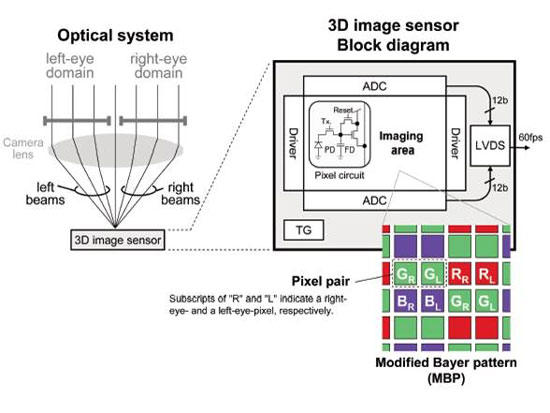 Panasonic develops a new 2.1-Mpixel CMOS image sensor that can capture 3D videos with a single lens, traditionally, two lenses and two CMOS sensors are required to take 3D video.
Panasonic develops a new 2.1-Mpixel CMOS image sensor that can capture 3D videos with a single lens, traditionally, two lenses and two CMOS sensors are required to take 3D video.
In the newly developed Sensor For taking 3D video we have to make sure that the two types of lights come to different pixels of the CMOS sensor. The new design is composed of a structure that combines a lenticular lens and mirror elements (digital micro lenses: DMLs) made by forming patterns whose size is smaller than light wavelength with a lithography technology.
lights separated by the lenticular lens are collected with the DMLs to increase their intensities. Then, they enter the pixels of the CMOS sensor. With this structure, the light entering the left eye and the light entering the right eye do not interfere with each other much. Therefore, the intensities of the lights become high enough.
The received signals obtained in this way are processed via line memory to create 3D video.
Panasonic is expected to start mass production of sensors from 2014.
via – techon.nikkeibp.co.jp







It’s an interesting development but there are a few issues.
1. Because it will use only one lens, it won’t provide very dramatic 3d. The sources of light input (lenses or eyes) have to be far enough apart for 3d effect to occur.
The closer the 2 input sources, the less 3d. One lens means there will be almost no 3d.
HOWEVER for macro photography or medical or scientific applications it may very well provide stellar results.
2. What size is the sensor? Unless mpixels means something different than megapixels, it would be a crap spap and shoot, so it’s probably for medical or scientific imaging, or a cheap gimmicky toy camera.
The lenticular element at input is a neat innovation. A lenticular lens isn’t a camera lens. Its transparent ribbed plastic, sort of like hundreds of tiny prisms. It’s implementation at the BEGINNING of the 3d process is very innovative and has astounding potential.
the image that a lenticular lens turns 3d is really a series of images that are interlaced together. Heres the kicker. if it’s only 2 images it looks like crap, but if it’s 4 or more images the result is pleasing.
in a lenticular picture the lens is combinging several images into one 3d picture. BUT at the capture phase, it is used to capture image information from more than one source and THEN combine it all into one image in camera. The single lens concept here doesn’t have to be just one lens. It could be 20 lenses! The light from these multiple camera lenses would pass thru the lenticular “lens” and combine on the sensor as 1 image, rather than many images which would have to be combined in photoshop as is done for current lenticular image production.
The resulting image could be printed by a lenticular printing company for a glasses free 3d photo or the video could be then played back on a screen fitted with a corresponding lenticular “lens” and you’d have glasses free 3d that is combining more sources than just 2.
Waitaminute! This is just one lens, not a whole camera. They could be intending to combine this with other lenses on one camera body – that might explain why the sensor is only 2 megapixels. That would be killer. Though it might have been more killer if it allowed for multiple camera lenses passing image info thru the lenticular lens onto an aps c sized sensor.
Or even better a camera system that allowed you to add more lenses in a modular way.